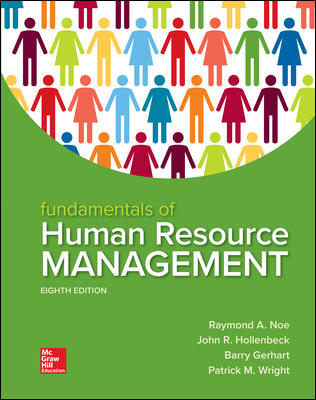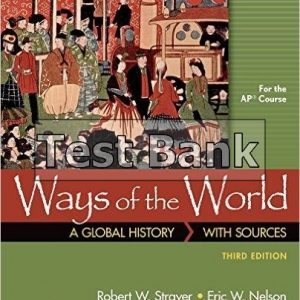This is completed downloadable of Test Bank for Fundamentals of Human Resource Management 8th by Noe

Product Details:
- ISBN-10 : 1260079171
- ISBN-13 : 978-1260079173
- Author:
Applicable to both HR majors and non-majors, Fundamentals of Human Resource Management, 8e, focuses on human resource issues and how HR is a key component of any company’s overall corporate strategy. With Fundamentals of Human Resource Management, 8e, students learn about best practices and are actively engaged through the use of cases and decision making. As a result, students will be able to take what they have learned in the course and apply it to solving HRM problems they will encounter on the job.
Table of Content:
- Part 1: The Human Resource Environment
- 1: Managing Human Resources
- Introduction
- Human Resources and Company Performance
- Responsibilities of Human Resource Departments
- Analyzing and Designing Jobs
- Recruiting and Hiring Employees
- Training and Developing Employees
- Managing Performance
- Planning and Administering Pay and Benefits
- Best Practices: HRM Helps Abbott Laboratories Thrive
- Maintaining Positive Employee Relations
- HRM Social: Social Media Tools for HR Professionals
- Establishing and Administering Personnel Policies
- Managing and Using Human Resource Data
- Ensuring Compliance with Labor Laws
- HR How To: Applying HR Data to Solve Business Problems
- Supporting the Organization’s Strategy
- HR Analytics & Decision Making
- Skills of HRM Professionals
- HR Oops!: Zenefits Runs into Its Own HR Issues
- HR Responsibilities of Supervisors
- Ethics in Human Resource Management
- Did You Know?: Employers’ Reputations Have Value
- Employee Rights
- Standards for Ethical Behavior
- Careers in Human Resource Management
- Organization of This Book
- Thinking Ethically: Whom Does the HR Professional Represent?
- Summary
- Key Terms
- Review And Discussion Questions
- Self-Assessment Exercise
- Taking Responsibility: Why Good Things Happen at Costco
- Managing Talent: Old Navy’s Talent Strategy Fills in Some Gaps
- HR in Small Business: Network Is the Key to HRM at 1Collision
- Notes
- 2: Trends in Human Resource Management
- Introduction
- Change in the Labor Force
- An Aging Workforce
- A Diverse Workforce
- Best Practices: Helping Panda Express Workers Communicate
- Skill Deficiencies of the Workforce
- HR Analytics & Decision Making
- High-Performance Work Systems
- Knowledge Workers
- Employee Empowerment
- HRM Social: Glassdoor Reviews Foster Better Communication
- Teamwork
- Focus on Strategy
- Mergers and Acquisitions
- HR Oops!: HRM Barely Gets a Passing Grade
- High-Quality Standards
- Cost Control
- Expanding into Global Markets
- Technological Change in HRM
- HR Information Systems
- People Analytics
- Sharing of Human Resource Information
- HR How To: Handling HR Implications of Artificial Intelligence
- Change in the Employment Relationship
- A Psychological Contract
- Did You Know?: Half of U.S. Employees Looking to Change Jobs
- Declining Union Membership
- Flexibility
- Thinking Ethically: How Solid Is Your Digital Footprint?
- Summary
- Key Terms
- Review and Discussion Questions
- Self-Assessment Exercise
- Taking Responsibility: Paychex Keeps People by Helping Them Retire
- Managing Talent: Employee Engagement Helps Bank’s Business
- HR in Small Business: New Belgium Brews Success through Employee Ownership
- Notes
- 3: Providing Equal Employment Opportunity and a Safe Workplace
- Introduction
- Regulation of Human Resource Management
- Equal Employment Opportunity
- Constitutional Amendments
- Legislation
- HR Analytics & Decision Making
- Executive Orders
- The Government’s Role in Providing for Equal Employment Opportunity
- Equal Employment Opportunity Commission (EEOC)
- Office of Federal Contract Compliance Programs (OFCCP)
- Businesses’ Role in Providing for Equal Employment Opportunity
- Avoiding Discrimination
- HRM Social: Using Social Media in Hiring Poses Discrimination Risk
- Providing Reasonable Accommodation
- Preventing Sexual Harassment
- HR Oops!: Disability Inclusion Still Falls Short
- Valuing Diversity
- Best Practices: Accenture’s Diversity Policies Welcome LGBT Workers
- Occupational Safety and Health Act
- General and Specific Duties
- Enforcement of the Occupational Safety and Health Act
- HR How To: Providing Safety from Gun Violence
- Employee Rights and Responsibilities
- Impact of the Occupational Safety and Health Act
- Employer-Sponsored Safety and Health Programs
- Identifying and Communicating Job Hazards
- Reinforcing Safe Practices
- Promoting Safety Internationally
- Did You Know?: Top 10 OSHA Violations
- Thinking Ethically: Is It Ethical to Discriminate Against the Unemployed?
- Summary
- Key Terms
- Review and Discussion Questions
- Self-Assessment Exercise
- Taking Responsibility: Keeping Subcontractors Safe
- Managing Talent: Google’s Search for Diverse Talent
- HR in Small Business: Airbnb Continues to Address Diversity Challenge
- Notes
- 4: Analyzing Work and Designing Jobs
- Introduction
- Work Flow in Organizations
- Work Flow Analysis
- Work Flow Design and an Organization’s Structure
- HR Oops!: Poor Planning for Robots
- Job Analysis
- Job Descriptions
- Job Specifications
- Sources of Job Information
- Position Analysis Questionnaire
- Fleishman Job Analysis System
- Analyzing Teamwork
- Importance of Job Analysis
- HRM Social: Skills of a Social-Media Specialist
- Competency Models
- Trends in Job Analysis
- Job Design
- Designing Efficient Jobs
- Best Practices: Navicent Health Gets Lean for the Sake of Its Patients
- Designing Jobs That Motivate
- HR How To: Devising a Plan for Workplace Flexibility
- Designing Ergonomic Jobs
- Did You Know?: Health Care Workers Need Ergonomic Job Design
- HR Analytics & Decision Making
- Designing Jobs That Meet Mental Capabilities and Limitations
- Thinking Ethically: How Can You Ethically Design a Dangerous Job?
- Summary
- Key Terms
- Review and Discussion Questions
- Self-Assessment Exercise
- Taking Responsibility: Mayo Clinic Prescribes a Dose of Efficient Work Design
- Managing Talent: Flexibility Drives Uber’s Growth
- HR in Small Business: Blink UX Takes a Hard Look at Work Design
- Notes
- Part 2: Acquiring, Training, and Developing Human Resources
- 5: Planning for and Recruiting Human Resources
- Introduction
- The Process of Human Resource Planning
- Forecasting
- Goal Setting and Strategic Planning
- HR How To: Using Temporary Employees and Contractors
- Implementing and Evaluating the HR Plan
- HR Analytics & Decision Making
- Applying HR Planning to Affirmative Action
- Best Practices: Fixing the Talent Gap
- Recruiting Human Resources
- Personnel Policies
- Did You Know?: Employers Prefer Internal Recruitment
- Recruitment Sources
- Internal Sources
- External Sources
- HRM Social: Effective Recruitment via Social Networks
- Evaluating the Quality of a Source
- Recruiter Traits and Behaviors
- HR Oops!: Fuzzy Source-of-Hire Data
- Characteristics of the Recruiter
- Behavior of the Recruiter
- Enhancing the Recruiter’s Impact
- Thinking Ethically: Is Temp and Contract Work Fair to Workers?
- Summary
- Key Terms
- Review and Discussion Questions
- Self-Assessment Exercise
- Taking Responsibility: Facebook’s Approach to Recruiting Employees
- Managing Talent: Techtonic Group Builds Its Own Labor Supply
- HR in Small Business: GenMet’s Design for Constructing a 21st-Century Workforce
- Notes
- 6: Selecting Employees and Placing Them in Jobs
- Introduction
- Selection Process
- Reliability
- Validity
- Ability to Generalize
- Practical Value
- Best Practices: Unilever Improves Selection Results with AI
- Legal Standards for Selection
- HRM Social: Screening with Social Media Poses Risks
- HR How To: Using Data Analytics to Support Fair Hiring Decisions
- Job Applications and Résumés
- Application Forms
- Résumés
- HR Analytics & Decision Making
- References
- Background Checks
- Did You Know?: Most Employers Use Social Media in Employee Selection
- Employment Tests and Work Samples
- Physical Ability Tests
- Cognitive Ability Tests
- Job Performance Tests and Work Samples
- Personality Inventories
- Honesty Tests and Drug Tests
- Medical Examinations
- Interviews
- Interviewing Techniques
- Advantages and Disadvantages of Interviewing
- Preparing to Interview
- Selection Decisions
- How Organizations Select Employees
- HR Oops!: Red Flags during Job Interviews
- Communicating the Decision
- Thinking Ethically: What Is an Employer’s Ethical Duty to Check Facts?
- Summary
- Key Terms
- Review and Discussion Questions
- Self-Assessment Exercise
- Taking Responsibility: At PepsiCo, Workers with Disabilities Are Encouraged, Not Disqualified
- Managing Talent: Marriott Hires People Who Put Others First
- HR in Small Business: Strategic Hiring at Skookum Digital Works
- Notes
- 7: Training Employees
- Introduction
- Training Linked to Organizational Needs
- Needs Assessment
- Organization Analysis
- Did You Know?: Many Service-Sector Workers Lack Basic Skills
- Person Analysis
- Task Analysis
- Readiness for Training
- Employee Readiness Characteristics
- Work Environment
- HRM Social: LinkedIn Learning: Today’s Corporate Training Center
- Planning the Training Program
- Objectives of the Program
- In-House or Contracted Out?
- Choice of Training Methods
- Training Methods
- Classroom Instruction
- Computer-Based Training
- HR How To: Using Wearable Technology to Support Training
- On-the-Job Training
- Simulations
- Business Games and Case Studies
- Behavior Modeling
- Experiential Programs
- Team Training
- Action Learning
- Implementing the Training Program
- Principles of Learning
- HR Oops!: So Far, Anti-Harassment Training Has Not Ended Harassment
- Transfer of Training
- Measuring the Results of Training
- Evaluation Methods
- HR Analytics & Decision Making
- Applying the Evaluation
- Applications of Training
- Best Practices: Verizon Ensures Training Adds Business Value
- Orientation and Onboarding of New Employees
- Diversity Training
- Thinking Ethically: Are Internships Opportunity or Exploitation?
- Summary
- Key Terms
- Review and Discussion Questions
- Self-Assessment Exercise
- Taking Responsibility: Training Helps Keep Goodyear’s Workers Safe
- Managing Talent: Huntington Ingalls Builds a Workforce to Do “Hard Stuff”
- HR in Small Business: Zeigler Auto Group Drives Growth by Training Its People
- Notes
- 8: Developing Employees for Future Success
- Introduction
- Training, Development, and Career Management
- Development and Training
- Development for Careers
- Approaches to Employee Development
- Formal Education
- Best Practices: Valvoline’s Development Program Ensures a Flow of New Managers
- Assessment
- Job Experiences
- Interpersonal Relationships
- HRM Social: Using Social Media for Career Development
- HR How To: Coaching Employees
- Systems for Career Management
- HR Analytics & Decision Making
- HR Oops!: Show Some Appreciation or Employees Will Leave
- Data Gathering
- Feedback
- Goal Setting
- Action Planning and Follow-Up
- Did You Know?: Men Named John Outnumber Women at the Top
- Development-Related Challenges
- The Glass Ceiling
- Succession Planning
- Dysfunctional Managers
- Thinking Ethically: Should Companies Tell Employees They Have “High Potential”?
- Summary
- Key Terms
- Review and Discussion Questions
- Self-Assessment Exercise
- Taking Responsibility: Employee Ambitions Drive Development at West Monroe Partners
- Managing Talent: Mondelez Bakes Development into Its Talent Strategy
- HR in Small Business: How Service Express Serves Employees First
- Notes
- Part 3: Assessing and Improving Performance
- 9: Creating and Maintaining High-Performance Organizations
- Introduction
- High-Performance Work Systems
- Elements of a High-Performance Work System
- HR How To: Rewarding High Performance
- Outcomes of a High-Performance Work System
- Conditions That Contribute to High Performance
- Teamwork and Empowerment
- HR Oops!: How Starbucks Recovered from a Decision Gone Wrong
- Knowledge Sharing
- Job Satisfaction and Employee Engagement
- Did You Know?: Only 33% of U.S. Workers Feel Engaged at Their Jobs
- Ethics
- HRM’s Contribution to High Performance
- HRM Practices
- HRM Technology
- HRM Applications
- Human Resource Information Systems
- HR Analytics & Decision Making
- Human Resource Management Online: E-HRM
- HRM Social: Companies Should Listen as Well as Talk on Social Media
- Effectiveness of Human Resource Management
- Human Resource Management Audits
- Best Practices: Data Taught KinderCare How to Build Success
- Analyzing the Effect of HRM Programs
- Thinking Ethically: Is Analyzing Employee Sentiment an Invasion of Privacy?
- Summary
- Key Terms
- Review and Discussion Questions
- Self-Assessment Exercise
- Taking Responsibility: The Container Store Continues to Put Employees First
- Managing Talent: How Adobe’s People and Rewards Contribute to High Performance
- HR in Small Business: Tasty Catering Serves Up Employee-Friendly Culture
- Notes
- 10: Managing Employees’ Performance
- Introduction
- The Process of Performance Management
- Purposes of Performance Management
- Best Practices: Goldman Sachs Makes Performance Management a Priority
- Criteria for Effective Performance Management
- HR Oops!: Employees Unclear on Performance Expectations
- Methods for Measuring Performance
- Making Comparisons
- Rating Individuals
- Did You Know?: Top Metrics in Performance Appraisals
- Measuring Results
- Total Quality Management
- Sources of Performance Information
- Managers
- Peers
- Subordinates
- HRM Social: Apps Are Enabling Real-Time Feedback
- Self
- Customers
- Errors in Performance Measurement
- Types of Rating Errors
- Ways to Reduce Errors
- Political Behavior in Performance Appraisals
- Giving Performance Feedback
- Scheduling Performance Feedback
- HR Analytics & Decision Making
- Preparing for a Feedback Session
- Conducting the Feedback Session
- Finding Solutions to Performance Problems
- HR How To: Delivering Positive Feedback
- Legal and Ethical Issues in Performance Management
- Legal Requirements for Performance Management
- Electronic Monitoring and Employee Privacy
- Thinking Ethically: What are the Ethical Boundaries of Tracking Employee Activities?
- Summary
- Key Terms
- Review and Discussion Questions
- Self-Assessment Exercise
- Taking Responsibility: Asana’s Performance Management Aligns with Its Values
- Managing Talent: Deloitte’s Approach to Performance Management Pays Off
- HR in Small Business: Retrofit’s Mobile Performance Management
- Notes
- 11: Separating and Retaining Employees
- Introduction
- Managing Voluntary and Involuntary Turnover
- Employee Separation
- Principles of Justice
- HR How To: Handling Rude Behavior
- Legal Requirements
- HRM Social: Firing an Employee for Social-Media Use
- Progressive Discipline
- Alternative Dispute Resolution
- Employee Assistance Programs
- Outplacement Counseling
- Did You Know?: Opioid Abuse Is a Problem for Workers and Employers
- Employee Engagement
- Job Withdrawal
- Job Dissatisfaction
- Behavior Change
- Physical Job Withdrawal
- Psychological Withdrawal
- HR Oops!: Employees Say Anything to Stay Away from Work
- Job Satisfaction
- Personal Dispositions
- Tasks and Roles
- Supervisors and Co-Workers
- Best Practices: At Quicken Loans, Employees Are the Most Valuable Asset
- Pay and Benefits
- HR Analytics & Decision Making
- Monitoring Job Satisfaction
- Thinking Ethically: Is it Ethical to Fire by Texting or Tweeting?
- Summary
- Key Terms
- Review and Discussion Questions
- Self-Assessment Exercise
- Taking Responsibility: Yahoo’s Struggle to Get Employees Cheering Again
- Managing Talent: Walmart Refocuses Its Employee Retention Strategies
- HR in Small Business: Happy Employees the Key to Radio Flyer’s Success
- Notes
- Part 4: Compensating Human Resources
- 12: Establishing a Pay Structure
- Introduction
- Decisions about Pay
- Legal Requirements for Pay
- Equal Employment Opportunity
- HR How To: Closing the Pay Gap
- Minimum Wage
- Overtime Pay
- Child Labor
- Prevailing Wages
- Pay Ratio Reporting
- Economic Influences on Pay
- Product Markets
- Labor Markets
- Did You Know?: A Majority of Workers Are Reluctant to Negotiate Pay
- Pay Level: Deciding What to Pay
- Gathering Information about Market Pay
- HR Analytics & Decision Making
- HRM Social: Crowdsourcing Pay Data
- Employee Judgments about Pay Fairness
- Judging Fairness (Equity)
- HR Oops!: Employees Doubt Their Pay Is Fair
- Communicating Fairness
- Job Structure: Relative Value of Jobs
- Pay Structure: Putting It All Together
- Pay Rates
- Best Practices: Parkland Health Rethinks Entry-Level Pay Rates
- Pay Grades
- Pay Ranges
- Pay Differentials
- Alternatives to Job-Based Pay
- Pay Structure and Actual Pay
- Current Issues Involving Pay Structure
- Pay during Military Duty
- Pay for Executives
- Thinking Ethically: Is Pay Disparity in the Fast-Food Business Ethical?
- Summary
- Key Terms
- Review and Discussion Questions
- Self-Assessment Exercise
- Taking Responsibility: IKEA Tries to Provide a Living Wage
- Managing Talent: How Target Aims for Competitive Employee Wages
- HR in Small Business: Jet.com’s No-Haggle Approach to Compensation
- Notes
- 13: Recognizing Employee Contributions with Pay
- Introduction
- Incentive Pay
- Did You Know?: Merit Pay Helps Retain Workers
- Pay for Individual Performance
- Piecework Rates
- Standard Hour Plans
- Merit Pay
- HR Analytics & Decision Making
- Performance Bonuses
- Sales Commissions
- Best Practices: AutoNation Offers a Choice of Commissions
- Pay for Group Performance
- Gainsharing
- Group Bonuses and Team Awards
- Pay for Organizational Performance
- Profit Sharing
- Stock Ownership
- HR Oops!: Thanks, but We’d Rather Have Cash
- Balanced Scorecard
- HRM Social: Social-Media Measures for a Balanced Scorecard
- Processes That Make Incentives Work
- Participation in Decisions
- Communication
- HR How To: Making Incentive Pay Part of a Total-Rewards Package
- Incentive Pay for Executives
- Performance Measures for Executives
- Ethical Issues
- Thinking Ethically: Can Incentives Promote Ethics?
- Summary
- Key Terms
- Review and Discussion Questions
- Self-Assessment Exercise
- Taking Responsibility: BNY Mellon Shares the Wealth with Employees
- Managing Talent: Employees Are Getting a Bite of Apple’s Stock
- HR in Small Business: Chobani Founder Plans to Share the Wealth
- Notes
- 14: Providing Employee Benefits
- Introduction
- The Role of Employee Benefits
- Benefits Required by Law
- Social Security
- Unemployment Insurance
- Workers’ Compensation
- Unpaid Family and Medical Leave
- Health Care Benefits
- HR How To: Keeping Up with U.S. Health Care Laws
- Optional Benefits Programs
- Paid Leave
- Group Insurance
- Retirement Plans
- Best Practices: How Microsoft Made Financial Health Contagious
- “Family-Friendly” Benefits
- HRM Social: Crowdfunding for College Savings Plans
- Other Benefits
- Selecting Employee Benefits
- The Organization’s Objectives
- HR Analytics & Decision Making
- Employees’ Expectations and Values
- Benefits’ Costs
- HR Oops!: Some Companies Are Clueless about Wellness ROI
- Legal Requirements for Employee Benefits
- Tax Treatment of Benefits
- Antidiscrimination Laws
- Accounting Requirements
- Communicating Benefits to Employees
- Did You Know?: Many Employees Need Help to Understand Their Benefits
- Thinking Ethically: Is It Fair Part-Timers Rarely Get Benefits?
- Summary
- Key Terms
- Review and Discussion Questions
- Self-Assessment Exercise
- Taking Responsibility: Kronos Trusts Employees Enough to Give Unlimited PTO
- Managing Talent: Investing in Young Workers at Credit Suisse
- HR in Small Business: Why Kickstarter Kicked Out Unlimited Vacation
- Notes
- Part 5: Meeting Other HR Goals
- 15: Collective Bargaining and Labor Relations
- Introduction
- Role of Unions and Labor Relations
- National and International Unions
- Local Unions
- Trends in Union Membership
- Unions in Government
- Did You Know?: Profile of a Typical Union Worker
- Impact of Unions on Company Performance
- Goals of Management, Labor Unions, and Society
- Management Goals
- Best Practices: Desire for More Jobs Unites Lear and the UAW
- Labor Union Goals
- Societal Goals
- Laws and Regulations Affecting Labor Relations
- National Labor Relations Act (NLRA)
- HRM Social: Employee Rights in the Social-Media Era
- Laws Amending the NLRA
- National Labor Relations Board (NLRB)
- HR How To: Writing an Employee Handbook That Follows NLRB Guidance
- Union Organizing
- The Process of Organizing
- Management Strategies
- Union Strategies
- Decertifying a Union
- Collective Bargaining
- Bargaining over New Contracts
- When Bargaining Breaks Down
- Work Stoppages
- Contract Administration
- HR Oops!: Arbitration Agreement Gets Out of Hand
- New Approaches to Labor Relations
- Labor–Management Cooperation
- Nonunion Representation Systems
- Thinking Ethically: Free Ride or Free Speech?
- Summary
- Key Terms
- Review and Discussion Questions
- Self-Assessment Exercise
- Taking Responsibility: Teamsters and UPS Strike a Deal for the 21st Century
- Managing Talent: Teachers Win over Unions and State Government
- HR in Small Business: Huffington Post Accepts Collective Bargaining
- Notes
- 16: Managing Human Resources Globally
- Introduction
- HRM in a Global Environment
- Best Practices: Chobani’s Global Outlook Was in Place from Its Founding
- Employees in an International Workforce
- Employers in the Global Marketplace
- Factors Affecting HRM in International Markets
- Culture
- HR Analytics & Decision Making
- HR Oops!: Cross-Cultural Management Missteps
- Education and Skill Levels
- Economic System
- Political-Legal System
- Human Resource Planning in a Global Economy
- Selecting Employees in a Global Labor Market
- Training and Developing a Global Workforce
- Training Programs for an International Workforce
- Cross-Cultural Preparation
- HRM Social: Online Communities Support Expats’ Spouses
- Global Employee Development
- Performance Management across National Boundaries
- Compensating an International Workforce
- Pay Structure
- Incentive Pay
- Employee Benefits
- International Labor Relations
- HR How To: Making the Most of an Overseas Assignment
- Managing Expatriates
- Selecting Expatriate Managers
- Preparing Expatriates
- Managing Expatriates’ Performance
- Compensating Expatriates
- Did You Know?: The Most Expensive Cities Are Concentrated in Asia
- Helping Expatriates Return Home
- Thinking Ethically: What Do Employers Owe LGBT Employees in Expat Assignments?
- Summary
- Key Terms
- Review and Discussion Questions
- Self-Assessment Exercise
- Taking Responsibility: Automation Changes Bangladesh Garment Industry
- Managing Talent: Geely Goes Global with Volvo (and Others)
- HR in Small Business: How 99designs Created a Global Enterprise with Just a Few Employees
- Notes
- Glossary
- Name and Company Index
- Subject Index





